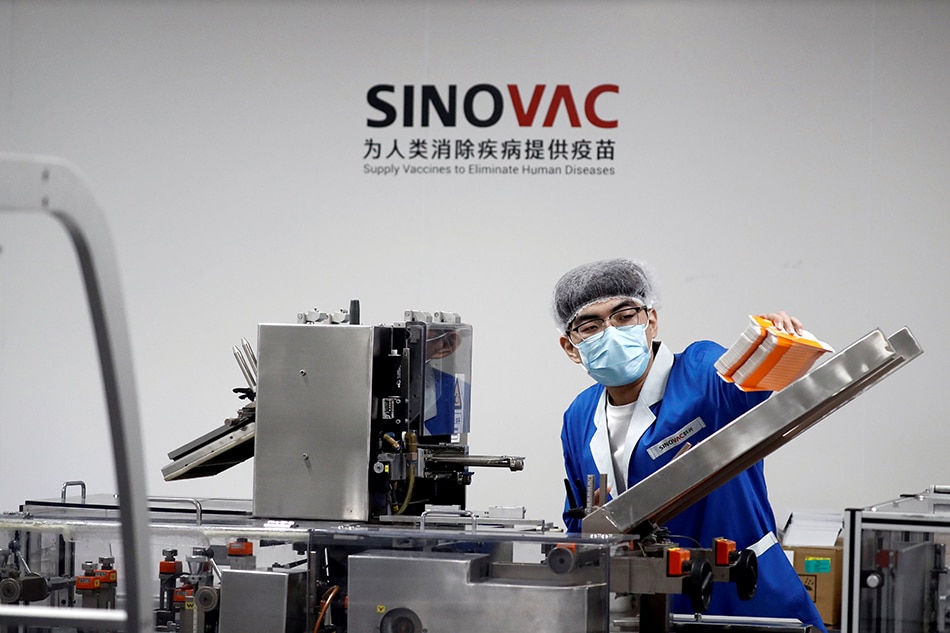The efficacy rate and what it really means | ABS-CBN
ADVERTISEMENT

Welcome, Kapamilya! We use cookies to improve your browsing experience. Continuing to use this site means you agree to our use of cookies. Tell me more!
The efficacy rate and what it really means
The efficacy rate and what it really means
Edson Guido,
ABS-CBN Data Analytics
Published Dec 28, 2020 03:42 PM PHT
|
Updated Dec 28, 2020 03:56 PM PHT
The 50% efficacy rate of the Sinovac vaccine from China has made headlines recently.
The 50% efficacy rate of the Sinovac vaccine from China has made headlines recently.
For the Philippines' Department of Science and Technology, the 50% efficacy is "acceptable" given that is the minimum requirement set by the World Health Organization. The Department of Health also agreed, reassuring Filipinos that the Chinese vaccine indeed meets international standards.
For the Philippines' Department of Science and Technology, the 50% efficacy is "acceptable" given that is the minimum requirement set by the World Health Organization. The Department of Health also agreed, reassuring Filipinos that the Chinese vaccine indeed meets international standards.
Still, many have expressed concern as the reported efficacy of Sinovac lags behind the 95% efficacy rate of Pfizer and the 94% of Moderna's.
Still, many have expressed concern as the reported efficacy of Sinovac lags behind the 95% efficacy rate of Pfizer and the 94% of Moderna's.
So, what does 50% actually mean? How does it translate to real life? Let’s do the math.
So, what does 50% actually mean? How does it translate to real life? Let’s do the math.
ADVERTISEMENT
For instance, 50,000 participants in a clinical trial were split evenly between the vaccine and placebo groups. Of the 300 COVID-19 cases that were found, 200 were in the placebo group and only 100 were in the vaccine group. Mathematically, the efficacy rate is then equivalent to a 50% risk reduction. In this particular example, getting a vaccine reduced the infection risk to half of those unvaccinated.
For instance, 50,000 participants in a clinical trial were split evenly between the vaccine and placebo groups. Of the 300 COVID-19 cases that were found, 200 were in the placebo group and only 100 were in the vaccine group. Mathematically, the efficacy rate is then equivalent to a 50% risk reduction. In this particular example, getting a vaccine reduced the infection risk to half of those unvaccinated.
So here is what the efficacy rate means — and what it doesn’t mean.
So here is what the efficacy rate means — and what it doesn’t mean.
A 50% efficacy rate indicates that a person is 50% less likely to become infected relative to someone who didn’t get the vaccine.
A 50% efficacy rate indicates that a person is 50% less likely to become infected relative to someone who didn’t get the vaccine.
This does not mean that half of those who took the vaccine won’t get COVID-19 and the other half will. The efficacy rate is always relative to the risk of those who are exposed to the virus.
This does not mean that half of those who took the vaccine won’t get COVID-19 and the other half will. The efficacy rate is always relative to the risk of those who are exposed to the virus.
Because of this, it's important to know the infection risk for those who didn't get the vaccine. If we use the positivity rate of 5% as a proxy (the positivity rate of the Philippines in the last two weeks), then the risk of getting COVID-19 for those who took a vaccine of 50% efficacy is reduced to 2.5%. That is how the math works.
Because of this, it's important to know the infection risk for those who didn't get the vaccine. If we use the positivity rate of 5% as a proxy (the positivity rate of the Philippines in the last two weeks), then the risk of getting COVID-19 for those who took a vaccine of 50% efficacy is reduced to 2.5%. That is how the math works.
ADVERTISEMENT
Testing statistics on December 26:
- 14,291 tests, less than 15,000 for the 2nd straight day ⬇️
- 805 positives reported by labs
- 6.0% daily positivity rate ⚠️
- 8.4% cumulative positivity rate
- 24 testing backlogs
- 529,787 positives (Dec 26)
- 469,886 confirmed (Dec 27) https://t.co/DOgtMk1mQT pic.twitter.com/qfB2UlD6aq
— Edson (@EdsonCGuido) December 27, 2020
Testing statistics on December 26:
— Edson (@EdsonCGuido) December 27, 2020
- 14,291 tests, less than 15,000 for the 2nd straight day ⬇️
- 805 positives reported by labs
- 6.0% daily positivity rate ⚠️
- 8.4% cumulative positivity rate
- 24 testing backlogs
- 529,787 positives (Dec 26)
- 469,886 confirmed (Dec 27) https://t.co/DOgtMk1mQT pic.twitter.com/qfB2UlD6aq
However, it’s important to note that the efficacy rates were derived from clinical trials that happened under a controlled environment. These conditions may or may not be met in the real world. Hence, it’s possible that there will be a difference between the reported efficacy rates and the effectiveness of the vaccines.
However, it’s important to note that the efficacy rates were derived from clinical trials that happened under a controlled environment. These conditions may or may not be met in the real world. Hence, it’s possible that there will be a difference between the reported efficacy rates and the effectiveness of the vaccines.
Pfizer and Moderna vaccines need to be stored in lower temperatures to maintain their efficacy and the cold chain infrastructure will be a logistical challenge in some areas. Furthermore, with most COVID-19 vaccines requiring two doses, previous studies have shown that not everyone comes back for the second dose. These are just some of the hurdles that may potentially change efficacy rates in the real world.
Pfizer and Moderna vaccines need to be stored in lower temperatures to maintain their efficacy and the cold chain infrastructure will be a logistical challenge in some areas. Furthermore, with most COVID-19 vaccines requiring two doses, previous studies have shown that not everyone comes back for the second dose. These are just some of the hurdles that may potentially change efficacy rates in the real world.
To sum, a 50% efficacy rate doesn’t mean that the vaccine only works half of the time. Rather, this rate means the vaccine halved the chances of people who got the vaccine from becoming sick relative to those who didn’t get the vaccine.
To sum, a 50% efficacy rate doesn’t mean that the vaccine only works half of the time. Rather, this rate means the vaccine halved the chances of people who got the vaccine from becoming sick relative to those who didn’t get the vaccine.
Read More:
COVID-19
coronavirus
efficacy rate
vaccines
Sinovac
data analytics
pandemic
China Sinovac
Pfizer
Moderna
ADVERTISEMENT
ADVERTISEMENT



